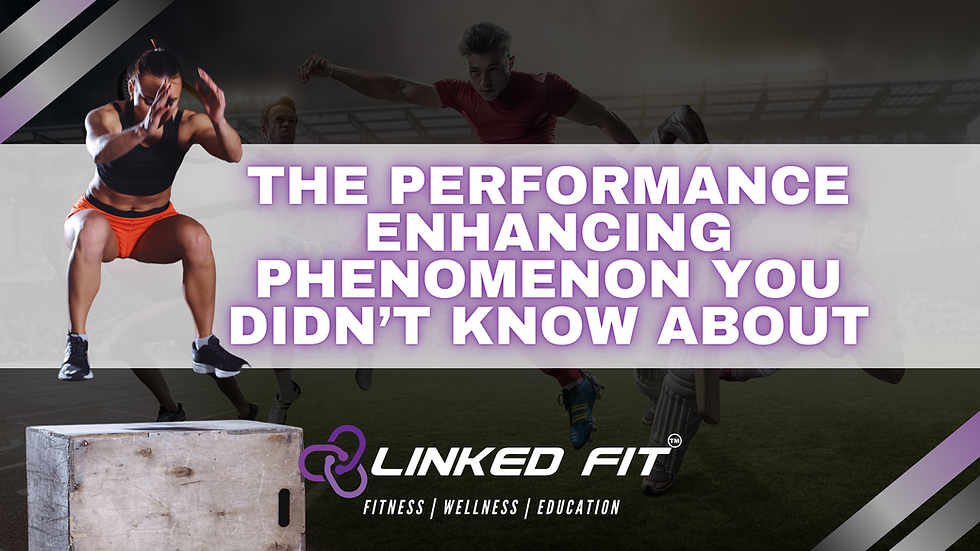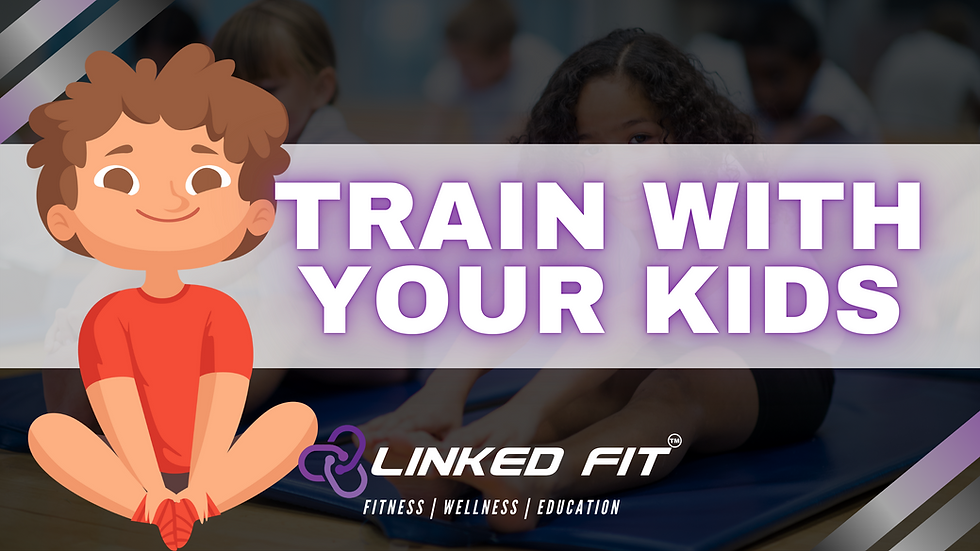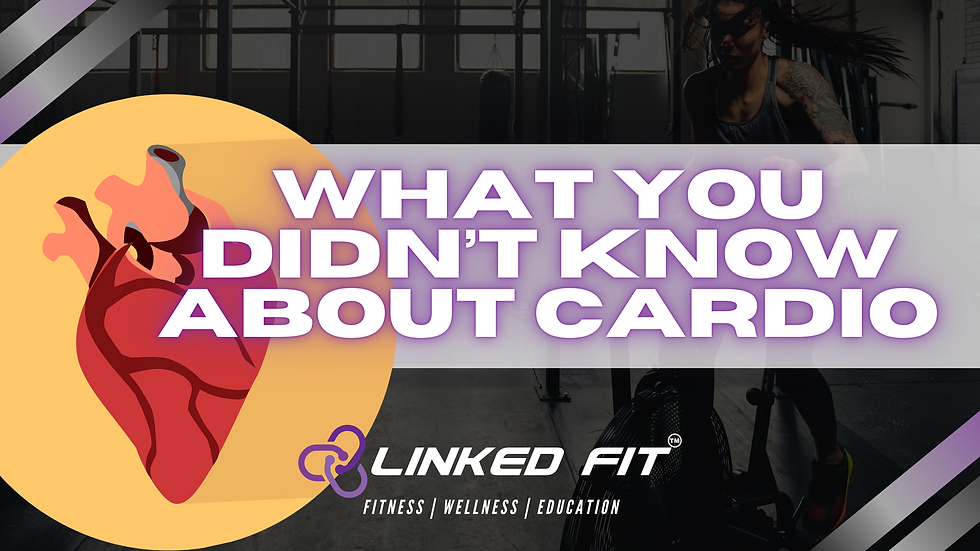Post-Training Protocol: Massage
- Linked Fit

- Nov 11, 2019
- 8 min read
As individual’s experience the dynamics from rigorous training sessions, it is important to have a protocol set in place after training to enhance recoverability. Failing to address an athletes need for optimal recovery may cause excessive build-up of unwanted fatigue and stress (Skorski et al., 2019). Skorski et al. (2019) state that neglecting to respect an athlete’s recovery can lead to non-functional overreaching or maladaptive training. Resources for optimal recovery will help improve muscular soreness, adaptability, and trigger parasympathetic activation (relaxation) which will complement the training program.
Massage has been promoted for physically active individuals for years. In particular, post-training massage can help by reducing cramping, decrease muscular soreness, enhance venous return, and promote lymphatic drainage (McGillicuddy, 2011). In recent years, research has been piling up about the use of foam rolling as a recovery method following training. The impairments following training can alter muscular function by central factors involving the central nervous system and nervous pathways to peripheral factors (Wiewelhove et al., 2019). The outcomes of peripheral fatigue include signs of ultrastructural damage of connective tissue and muscle tissue (Wiewelhove et al., 2019). A variety of biomechanical effects exists from post-training massage such as smaller increases in post-training plasma creatine kinase; activated mechano-sensory sensors that signal transcription of COX7B and ND1 (new mitochondria formation); and less active heat-shock proteins and immune cytokines (less stress and inflammation) (Wiewelhove et al., 2019). The use of rolling protocols can influence muscular tone by parasympathetic system activation, reflexes and pain tolerance, thus leading towards greater improvements in range-of-motion and pressure pain threshold (Behm & Wilke, 2019). However, the use of rollers still has insufficient evidence and the literature that does provide support needs to be strengthened.
The use of massage tools such as roller can help change myofascial tone through thixotropic properties, blood flow, and fascial hydration thus affecting the tissue stiffness (Behm & Wilke, 2019). A post-training massage has been shown to reduce muscle pain perceptions by 6% (Wiewelhove et al., 2019). The meta-analysis by Wiewelhove et al. (2019) was able to review that post-training massage can help recover exercise-induced decrements in sprint and strength performance more rapidly that a passive recovery approach. A variety of key factors need to be addressed, as it relates to the outcome of pressure pain threshold among the tissue: pressure, tool density, duration, and types of techniques.
PRESSURE
It is important to understand the pressure pain threshold when utilizing new tools and techniques of massage. Wilke, Vogt, and Banzer (2018) provide support with the different massage techniques utilizing a foam roller and how they impact the pressure pain threshold. A compression (not dynamic rolling) technique on the muscle belly helped reduced myofascial trigger points (Wilke et al., 2018). A myofascial trigger point is hyperirritable areas within the taunt bands of skeletal muscle tissue (Wilke et al., 2018). These trigger points have associated with the acceleration of muscular fatigability, muscle cramps, and alterations of muscular activation patterns (Wilke et al., 2018). It has been noted that the perception of pain may positively benefit the short-term recovery process of muscular function while heightening the perception of soreness (Wiewelhove et al., 2019). When muscular pain is present, the normal function of muscular contraction is impaired resulting in critical effects on exercise performance (Wiewelhove et al., 2019).
TOOL DENSITY
A variety of tools can be used for a massage technique from foam rollers, lacrosse balls, softballs, barbells, kettlebells, and many others. Although there are a variety of massage tools on the market, there is limited to no research on comparing the vast majority of tools (Behm & Wilke, 2019). The responses from massage compression forces vary by means of how the tool is performed by the individual. Borda and Selhorst (2017) utilized a lacrosse ball massage (self-guided) with a patient with Achilles tendinopathy. The use of the lacrosse ball massage with compression tack/flossing and eccentric exercise benefited the patient's pain and function of the lower extremity (Borda & Selhorst, 2017). The direct pressure of the massage tool may produce a local mechanical and global neurophysiological effect that can direct tissue relaxation and pressure pain threshold in the specific or surrounding tissue (Cheatham & Stull, 2018b).

In responses of protective muscle guarding during massage rolling, a high-density massage tool or roller is likely to produce more discomfort which doesn’t necessarily mean “greater” muscle relaxation (Cheatham & Stull, 2018b). Thus, selecting a tool density should be based on individual experiences rather than higher pain relationships.
DURATION
The time spent participating in a massage protocol after training can result in significant reactions to the tissue. Couture, Karlik, Glass, and Hatzel (2015) were able to provide support and compare two durations of foam rolling from each other. In the study, two-sets of 10-seconds and four-sets of thirty-seconds of foam rolling did not significantly benefit hamstring extensibility when compared. Therefore, this research helps contribute the composed question on what is an adequate massage duration to produce optimal extensibility from inhibitory actions in the muscle tissue.

Although the duration of a massage intervention outcome can be easily manipulated by the tool density, the pressure applied, and technique utilized, there is a correlation between massage duration and tissue extensibility (Debruyne, Dewhurst, Fischer, Wojtanowski, & Durall, 2017). Jay et al. (2014) studied the impact of a massage roller (stick) use on hamstring extensibility after 10-minutes of use. The results expressed a significant change in soreness, pressure pain threshold, and range of motion (Jay et al., 2014). Despite the substantial changes in variables after 10-minutes of rolling, this still doesn’t provide adequate support on what duration should be utilized after training. With that said, massage duration should be approached with caution and modified among the different populations practicing this post-training protocol. As individuals move forward in future recovery cycles, increase the duration of massage to advance the numerous adaptations that can be granted.
Individuals that have never practiced any massage technique should approach with caution. It is recommended to limit the time spent during massage following training until they have reached a respectful pressure and adaptations that will not result in pain.
TYPES OF TECHNIQUES
COMPRESSION
A compression (ischemic) consists of constant deep pressure by a tool that can be applied to myofascial trigger points (Morikawa et al., 2017). Morikawa et al. (2017) were able to study the implications of a compression technique on autonomic nervous system activity. After providing compression to a local myofascial trigger point, participants improved their pain perception and parasympathetic activity (high frequency and LF/HF ratio) increased, providing a promising outcome through the index of sympathovagal balance (Morikawa et al., 2017).
PARALLEL
A parallel technique provides a longitudinal stripping massage stroke along the muscle belly (Forman, Geertsen, & Rogers, 2014). This technique generally applies to the entire muscle group to isolate adhesions and/or hypertonic tissue (Forman et al., 2014). Forman et al. (2014) examined how a parallel massage technique (deep stripping massage) improved hamstring flexibility. The technique was able to improve the range of motion by 6.3% when compared with deep stripping massage plus eccentric resistance training (Forman et al., 2014).
PERPENDICULAR
The perpendicular technique provides a cross-friction (fiber) massage that applies the forces perpendicular (cross) to the separating fibers (Yoon, Yu, Lee, Kwak, & Kim, 2012). The technique is used to promote local hyperemia (increased blood flow to an area) and analgesia (pain reduction) to the muscle (Yoon et al., 2012). This massage technique may help deliver force to deep muscular areas to aid in the regeneration of connective tissue and reduce muscle stiffing following an incomplete inflammatory response (Farasyn, 2010; Yoon et al., 2012).
ACTIVE
An active technique within massage is described as a joint going through an active joint motion during the massage (Cheatham & Stull, 2018a). The work by Cheatham and Stull (2018a) shows that an active motion during foam rolling can provide a positive influence on passive range of motion and pressure pain threshold. Reciprocal inhibition and neural pathways may explain the outcomes of an active massage technique.
CIRCULAR
The circular massage technique provides the motion of circles in the given muscular area. The circular massage technique is similar to the effleurage massage stroke, but experienced and performed through self-regulations. The circular should always follow a specific pattern thus follow the direction of venous return back to the heart (Park et al., 2017). The theory behind a circular (effleurage) massage technique is that it may increase arterial blood flow, bringing oxygen and nutrients to the tissue more quickly (Park et al., 2017). Park et al. (2017) applied a form of circular (effleurage) massage with individuals with no ankle injury and it improved their functional reaching test. A circular massage technique may aid the degree of connective tissue manipulation thus leading towards a greater range of motion.
REFERENCE:
Behm, D. G., & Wilke, J. (2019). Do Self-Myofascial Release Devices Release Myofascia? Rolling Mechanisms: A Narrative Review. Sports Medicine, 49(8), 1173-1181. doi:10.1007/s40279-019-01149-y
Borda, J., & Selhorst, M. (2017). The use of compression tack and flossing along with lacrosse ball massage to treat chronic Achilles tendinopathy in an adolescent athlete: a case report. The Journal of manual & manipulative therapy, 25(1), 57-61. doi:10.1080/10669817.2016.1159403
Cheatham, S. W., & Stull, K. R. (2018a). Comparison of a foam rolling session with active joint motion and without joint motion: A randomized controlled trial. Journal of Bodywork and Movement Therapies, 22(3), 707-712. doi:10.1016/j.jbmt.2018.01.011
Cheatham, S. W., & Stull, K. R. (2018b). Comparison of Three Different Density Type Foam Rollers on Knee Range of Motion and Pressure Pain Threshold: A Randomized Controlled Trial. International Journal Of Sports Physical Therapy, 13(3), 474-482. Retrieved from https://www.ncbi.nlm.nih.gov/pubmed/30038833
Couture, G., Karlik, D., Glass, S. C., & Hatzel, B. M. (2015). The Effect of Foam Rolling Duration on Hamstring Range of Motion. The open orthopaedics journal, 9, 450-455. doi:10.2174/1874325001509010450
Debruyne, D. M., Dewhurst, M. M., Fischer, K. M., Wojtanowski, M. S., & Durall, C. (2017). Self-Mobilization Using a Foam Roller Versus a Roller Massager: Which Is More Effective for Increasing Hamstrings Flexibility? Journal of Sport Rehabilitation, 26(1), 94-100. doi:10.1123/jsr.2015-0035
Farasyn, A. (2010). Release of myofascial pain with deep cross-friction named "roptrotherapy". International journal of therapeutic massage & bodywork, 3(1), 36-37. Retrieved from https://www.ncbi.nlm.nih.gov/pubmed/21589700
Forman, J., Geertsen, L., & Rogers, M. E. (2014). Effect of deep stripping massage alone or with eccentric resistance on hamstring length and strength. Journal of Bodywork and Movement Therapies, 18(1), 139-144. doi:10.1016/j.jbmt.2013.04.005
Jay, K., Sundstrup, E., Søndergaard, S. D., Behm, D., Brandt, M., Særvoll, C. A., . . . Andersen, L. L. (2014). Specific and cross over effects of massage for muscle soreness: randomized controlled trial. International Journal Of Sports Physical Therapy, 9(1), 82-91. Retrieved from https://www.ncbi.nlm.nih.gov/pubmed/24567859
McGillicuddy, M. (2011). Massage for Sport Performance. Champaign, IL: Human Kinetics.
Morikawa, Y., Takamoto, K., Nishimaru, H., Taguchi, T., Urakawa, S., Sakai, S., . . . Nishijo, H. (2017). Compression at Myofascial Trigger Point on Chronic Neck Pain Provides Pain Relief through the Prefrontal Cortex and Autonomic Nervous System: A Pilot Study. Frontiers in Neuroscience, 11. doi:10.3389/fnins.2017.00186
Park, J., Shim, J., Kim, S., Namgung, S., Ku, I., Cho, M., . . . Roh, H. (2017). Application of massage for ankle joint flexibility and balance. Journal of physical therapy science, 29(5), 789-792. doi:10.1589/jpts.29.789
Skorski, S., Mujika, I., Bosquet, L., Meeusen, R., Coutts, A. J., & Meyer, T. (2019). The Temporal Relationship Between Exercise, Recovery Processes and Changes in Performance. International Journal of Sports Physiology and Performance, 1-23. doi:10.1123/ijspp.2018-0668
Wiewelhove, T., Döweling, A., Schneider, C., Hottenrott, L., Meyer, T., Kellmann, M., . . . Ferrauti, A. (2019). A Meta-Analysis of the Effects of Foam Rolling on Performance and Recovery. Frontiers in physiology, 10. doi:10.3389/fphys.2019.00376
Wilke, J., Vogt, L., & Banzer, W. (2018). Immediate effects of self-myofascial release on latent trigger point sensitivity: a randomized, placebo-controlled trial. Biology of sport, 35(4), 349-354. doi:10.5114/biolsport.2018.78055
Yoon, Y.-S., Yu, K.-P., Lee, K. J., Kwak, S.-H., & Kim, J. Y. (2012). Development and application of a newly designed massage instrument for deep cross-friction massage in chronic non-specific low back pain. Annals of rehabilitation medicine, 36(1), 55-65. doi:10.5535/arm.2012.36.1.55













Comments